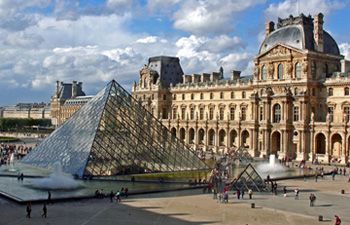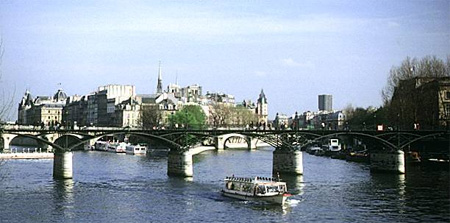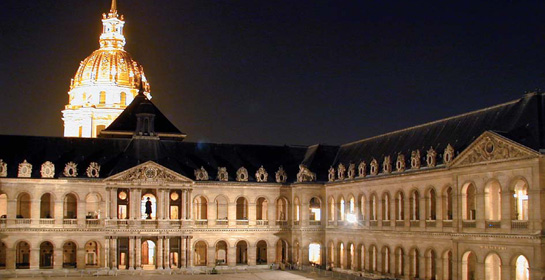|
France, a major industrialized nation, is the third largest country in Europe, after Russia and Ukraine, and the fourth most populous. Officially the French Republic (République Française), the nation includes ten overseas possessions, most of them remnants of France’s former colonial empire. Paris is the nation’s capital and largest city.
Roughly hexagonal in shape, France shares boundaries with Belgium and Luxembourg to the northeast; Germany, Switzerland, and Italy to the east; and Spain and Andorra to the southwest. In the northwest, France is bounded by the English Channel. At the Strait of Dover, the narrowest part of the channel, France and England are separated by just 34 km (now connected by an underwater tunnel available to trains only). France faces three major seas: the Atlantic Ocean to the west, the North Sea to the north, and the Mediterranean Sea to the southeast.
France is a nation of varied landscapes, ranging from coastal lowlands and broad plains in the north, to hilly uplands in south central France, to lush valleys and towering, snow-capped Alps in the east. Mountainous and hilly areas lie on nearly all of France’s borders, creating a series of natural boundaries for the country. Only the nation’s northeastern border is largely unprotected. Several major rivers drain France, including the Seine, Loire, Garonne, and Rhône.
France is highly urbanized. Three-quarters of the population lives in cities, including more than ten million people in the metropolitan area of Paris, the most densely populated region in France. The French are among the healthiest, wealthiest, and best-educated people in the world. A comprehensive social welfare system is in place, guaranteeing all citizens a minimal standard of living and health care. Most citizens speak French, the principal language. The dominant religion is Roman Catholicism.
| |
 |
| |
Versailles |
French culture, especially French art and literature, has profoundly influenced the Western world. Paris, one of the world’s great intellectual capitals, has been at the center of Western cultural life since the Middle Ages. World-renowned French cultural figures include philosophers, writers, painters, sculptors, architects, composers, playwrights, and film directors. French literary and artistic contributions during the Renaissance and the Age of Enlightenment deeply influenced the path of Western cultural development. Impressionism, an innovative painting movement in the late 19th century, originated in France. During the 20th century, French writers and artists were at the center of movements such as dada, surrealism, existentialism, and the theater of the absurd. France has a long reputation for excellence in cuisine, and French fashion styles are imitated throughout the world.
The economy of France is large, diverse, and one of the most highly developed in the European Union (EU). It is a leading manufacturing nation, producing goods such as automobiles, electrical equipment, machine tools, and chemicals. France is the EU’s most important agricultural nation – shipping cereals, wine, cheese, and other agricultural products to the rest of Europe and the world. In recent decades, service industries, including banking, retail and wholesale trade, communications, health care, and tourism, have come to dominate the French economy.
 |
|
| Haut Koenigsbourg |
|
France is one of the oldest states in the Western world and its history is rich and varied. Little is known of France’s earliest inhabitants. Cave paintings in southwestern France dated to about 15,000 BC reveal the existence of a sophisticated and creative people. By the 8th century BC hordes of Celts, among other tribes, began entering and settling in France. A Celtic word, Gaul, was a name used in antiquity for the region of France. The ancient Romans incorporated France in the 1st century BC and ruled the region until the Roman Empire collapsed in the 5th century AD.
After the fall of Rome, a series of royal dynasties ruled much of what would become France. Royal power declined in the Middle Ages with the spread of feudalism, which distributed power among local rulers. From the 14th to 18th century the power of the monarchy grew steadily as French kings and their ministers built a centralized bureaucracy and a large standing army. The French Revolution in 1789 toppled the monarchy, ushering in decades of political instability. Despite this turmoil, the revolution, and the subsequent rule of Napoleon Bonaparte, established a uniform administrative state in France.
French strength and prosperity grew during the 19th and early 20th centuries, and France built a worldwide colonial empire rivaling that of the United Kingdom. Much of World War I (1914-1918) was fought on French soil, and the nation suffered heavy losses. During World War II (1939-1945), Germany occupied northern France while a collaborationist regime was established at Vichy in central France. After the war France rebuilt its shattered economy and emerged as one of the world’s major industrial countries. Growing resistance to French rule in the colonies increased in the postwar period, triggering a wave of decolonization that stripped France of most of its overseas possessions.
In 1958 an uprising in Algeria, then a French colony, threatened France with civil war. The French government surrendered dictatorial power to Charles de Gaulle, a resistance leader during World War II, and invited de Gaulle to form a new government. French voters approved a new constitution by popular referendum that strengthened the powers of the presidency, and de Gaulle became the new government’s first president. De Gaulle viewed France as a great power, and he followed an independent stance in foreign affairs, a policy that helped boost France’s international influence. In recent decades, France, working closely with Germany, has played a leading role in the move toward greater European economic and political integration.
| |
 |
| |
Eiffel tower |
Paris (pop. 12 million), located in the north central France on the Seine River, is the capital and largest city of the country. Paris is world-famous for its beauty and charm, and for its long history as a center of learning and knowledge. Parisians call their city the 'City of Light.' People from around the world flock to the city to view its impressive array of monuments and museums, savor its cuisine, and relax in its sidewalk cafes and nightclubs. Paris is the political, cultural, and economic center of France as well as one of the most vibrant metropolises in the world. About 15% of France’s inhabitants live in the Paris metropolitan area.
Paris is named after the Parisii, a Celtic people who settled on the city’s central island – the Île de la Cité – in the 3rd century BC. The city has since spread north and south of the Seine. The city lies in a depression. The highest elevation is 129 m at the summit of Montmartre in northern Paris.
Paris enjoys a temperate climate. Average daily temperatures are 20°C in summer and 5°C in winter. The city receives about 650 mm of precipitation annually, spread evenly over the course of the year. Air pollution is high, caused predominantly by automobile traffic and aggravated by the city’s geographic position in a depression.
 |
|
| Louvre museum |
|
Paris contains around 150 museums, ranging from the Louvre – one of the largest and most famous museums in the world – to the very small Musée Zadkine. The Louvre houses an exceptional collection of Greek, Roman, and Egyptian antiquities, and great paintings of the French, Italian, Dutch, and Flemish schools. The Mona Lisa (1503-1506) of Leonardo da Vinci and the ancient Greek statues Venus of Milos (150-100 BC) and Victory of Samothrace (about 200 BC) are among its world-renowned treasures. The Musée d'Orsay, located in a converted railway station, is devoted to French painting, sculpture, photography, and other works of art created between 1848 and 1914. It is best known for its impressionist collection, the largest in France. The Musée Nationale d’Art Moderne (National Museum of Modern Art) is located in the Pompidou Center, near Les Halles. Devoted to 20th-century and contemporary art, the museum contains significant fauvist, cubist, and surrealist collections, among others. The 17th-century Hôtel des Invalides, built by Louis XIV as a hospice for war veterans, houses the Army Museum. Napoleon’s tomb is located in the Church of the Dome, built from 1676 to 1706 by Jules Hardouin-Mansart. The Invalides Esplanade extends to the Seine and bounds the Faubourg Saint-Germain to the west.
There are well over 100 theaters in Paris. Most are privately owned and they vary in size and fame, from the well-established to the experimental. The oldest and best known is the state-run Comédie Française, founded by Louis XIV, located at the Palais-Royal by the Louvre. The Théâtre de l’Odéon on the Left Bank and the Théâtre National at the Palais de Chaillot are also run by the French government. Parisians are keen filmgoers. In addition to the many multiscreen commercial cinemas, there are scores of repertoire cinemas in Paris, predominantly on the Left Bank, where quality films from around the world are screened.
| |
 |
| |
Pont des Arts, Paris |
The French national opera company performs large-scale operas at the Opéra de la Bastille, inaugurated in 1989, and stages chamber operas and ballets at the Palais Garnier, formerly the main opera house, at Place de l’ Opéra. The Théâtre Musical de Paris also performs operas, and the Théâtre de la Ville specializes in ballet and chamber music. Both are located at Place du Châtelet, and are run by the city.
The Salle Pleyel, northeast of the Arc de Triomphe, is home to the Paris Orchestra. Concerts are also held at the Théâtre des Champs-Élysées, the Louvre Auditorium, at the Musée d’Orsay, and in many churches and auditoriums. The Musée de Musique and the Conservatoire National Supérieur de Musique are located in the Cité de la Musique at the Parc de la Villette. Jazz and pop music concerts are also held at La Villette, as well as a variety of other entertainment. |
| • Venue - Hotel Accommodation |

FFB - Fédération Française de Bridge
20 Quai Carnot
FR-92 210, Sait-Cloud
France
|
|
|
The 8th European Champions' Cup will be hosted at the headquarters of the French Bridge Federation (FFB) in Sait-Cloud, on the outskirts of Paris. There will be a Vugraph presentation in the FFB auditorium (150 seats), while some matches will be broadcast by BBO.
The French Bridge Federation will offer the players a welcome cocktail and buffet meals on Thursday evening, and Friday, Saturday and Sunday lunch time. Free drinks will be available to all players during the tournament. The closing gala dinner will take place at the Army Museum in the prestigious Hotel National des Invalides, located in the center of Pairs. Buses will transport the players forth and back. Players are advised to use the buses, as parking facilities are limited. The entrance will be by the Main Countryard, especially enlightened. Drinks will be offered in the Quesnoy Rooms and dinner will be served in the Grand Salon.
• How to reach the FFB headquarters
 |
| a. |
Metro: Rhin et Danube (terminus line 10) and 7 min. walk |
 |
| b. |
Tram: line 2 (from La Défense), Parc de St. Cloud station and 2 min. walk |
 |
| Army museum |
|
Novotel Paris Pont de Sévres
(131 chambres)
11, 13 Grande Rue
FR-92 310, Sévres
|
|
|
Hôtel Campanile
(139 chambres)
15-17 Boulevard Henri Sellier
FR-
92 150, Suresnes
|
|
|

